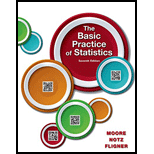
Concept explainers
To find: The experiment has.
Answer to Problem 11.1TY
Correct answer:
Option (c): Three treatments
Explanation of Solution
Reason for the correct answer:
Here, the subjects are imposed by certain experimental conditions for avoiding crops from getting damaged. The experimental conditions are beehives present, beehives absent and no beehives.
Thus, the treatments in the study are beehives present, beehives absent and no beehives.
Reason for the incorrect answers:
Option (a): Two factors, beehives present or absent
Beehives present or absent represent two of the three treatments given to the bees.
Option (b): Matched pair
Here, same bees are not randomly assigned to different treatments for beehives present, beehives absent and no beehives.
Option (d): Stratification by beehive.
Here, the whole group of bees is not divided in to two or more groups.
Thus, options (a), (b), and (d) are incorrect.
Conclusion:
Thus, the experiment has three treatments.
Introduction:
Treatments:
In an experimental study, the subjects are imposed under certain experimental conditions; these conditions are termed as treatments. If there are more than two factors in an experiment, then the treatment is the combination of the specific factor levels.
The explanatory variables in the experiment are termed as factors. The variable that can be changed or controlled in the experiment is termed as explanatory variable. The change in the response variable is explained by the explanatory variable.
Matched pairs experiment:
In matched pair design, two treatments are assigned randomly to the same subject that is each subject receives two types of treatments and are compared for the effect of the treatment. It is the experiment which is used for comparing of two treatments using blocking.
Stratified sampling:
In stratified sampling, the whole population is divided into two or more different subgroups based on the characteristics. Then from each subgroup, the units are selected and required sample is drawn.
Want to see more full solutions like this?
Chapter 11 Solutions
The Basic Practice of Statistics
 MATLAB: An Introduction with ApplicationsStatisticsISBN:9781119256830Author:Amos GilatPublisher:John Wiley & Sons Inc
MATLAB: An Introduction with ApplicationsStatisticsISBN:9781119256830Author:Amos GilatPublisher:John Wiley & Sons Inc Probability and Statistics for Engineering and th...StatisticsISBN:9781305251809Author:Jay L. DevorePublisher:Cengage Learning
Probability and Statistics for Engineering and th...StatisticsISBN:9781305251809Author:Jay L. DevorePublisher:Cengage Learning Statistics for The Behavioral Sciences (MindTap C...StatisticsISBN:9781305504912Author:Frederick J Gravetter, Larry B. WallnauPublisher:Cengage Learning
Statistics for The Behavioral Sciences (MindTap C...StatisticsISBN:9781305504912Author:Frederick J Gravetter, Larry B. WallnauPublisher:Cengage Learning Elementary Statistics: Picturing the World (7th E...StatisticsISBN:9780134683416Author:Ron Larson, Betsy FarberPublisher:PEARSON
Elementary Statistics: Picturing the World (7th E...StatisticsISBN:9780134683416Author:Ron Larson, Betsy FarberPublisher:PEARSON The Basic Practice of StatisticsStatisticsISBN:9781319042578Author:David S. Moore, William I. Notz, Michael A. FlignerPublisher:W. H. Freeman
The Basic Practice of StatisticsStatisticsISBN:9781319042578Author:David S. Moore, William I. Notz, Michael A. FlignerPublisher:W. H. Freeman Introduction to the Practice of StatisticsStatisticsISBN:9781319013387Author:David S. Moore, George P. McCabe, Bruce A. CraigPublisher:W. H. Freeman
Introduction to the Practice of StatisticsStatisticsISBN:9781319013387Author:David S. Moore, George P. McCabe, Bruce A. CraigPublisher:W. H. Freeman





